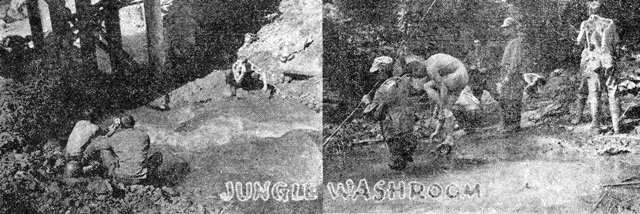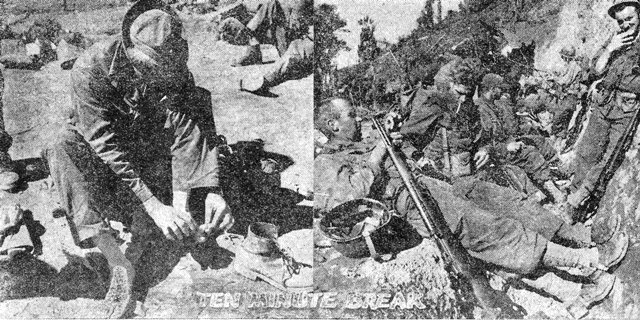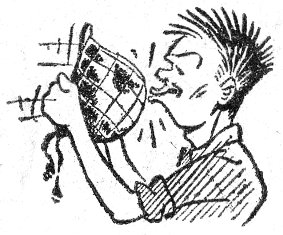
VOL. II NO. 27 REG NO. L5015 DELHI, THURSDAY MARCH 16, 1944

 The Ledo Road felt the weight of American Infantry shoes pounding upon its surface when doughboys, many of them
veterans of the Southwest Pacific, marched toward the Hukawng Valley, where they cut behind the Jap in a bold, flanking
sweep to capture Walawbum.
The Ledo Road felt the weight of American Infantry shoes pounding upon its surface when doughboys, many of them
veterans of the Southwest Pacific, marched toward the Hukawng Valley, where they cut behind the Jap in a bold, flanking
sweep to capture Walawbum.
|
CHINESE - AMERICAN SQUEEZE
YANKS PLAY VITAL PART IN VICTORY,
GREATEST IN ASIATIC COMBAT
NORTHERN BURMA - The Hukawng Valley, death trap for at least 3,500 Japanese, is virtually all in the hands of surging Chinese and American forces following a savage, week-long battle for Maingkwan and Walawbum, in which Chinese-manned American light tanks and American and Chinese Infantry combined in an enveloping movement executed so effectively that at least 2,000 of the enemy gained eternal glory by dying for their Emperor within seven days.
These same Allied troops, fighting shoulder to shoulder, are now conducting mopping-up operations in order to "glorify" the remaining encircled remnants of Tojo's legions.
REMNANTS FLEEING
Meanwhile, through the tangled jungles of the tapering southern end of the Hukawng Valley, the few battered survivors of the Japanese 18th Division able to escape the tight noose thrown around them, are staggering toward Jambu Bum Pass, 15 miles south of Walawbum, and are mustering delaying action along the route in preparation for an expected stand. The enemy is probably digging in at this hilly corridor to the Mogaung Valley, where terrain is best suited for defense.
At last reports, leading elements of the Chinese had pursued the fleeing Japanese five miles past Chanmoi, astride the main road artery leading to Jambu Bum Pass.
Pideful at the success of his Allied forces, made possible by the close cooperation of Chinese and American troops, Lt. Gen. Joseph W. Stilwell announced that the tanks had killed 500 Japanese during the week's action. Merrill's Marauders had slaughtered 800 more and his two Chinese divisions, the 38th and 22nd, had dispatched an additional 700. The few Japs, who succeeded in escaping fled over a cutoff trail joining to the main Hukawng Valley road south of Walawbum under protection of an artillery barrage.
ALLIES EXPLODE
After a couple of weeks of slow, painful ground gaining, Stilwell's forces exploded in all directions, starting March 3, in a manner that left the enemy confused, routed and demoralized. Some observers believe that the estimate of 2,000 dead is somewhat conservative, considering the Japs' practice of rapidly burying or burning their dead. The sense of smell, highly developed now among the Allies, leads them daily to new piles of corpses dedicated to the Land of the Sinking Sun.
The Jap exodus was so frantic that the 38th Division, commanded by Maj. Gen. Sun Li-jen, captured three large ammunition dumps, containing two armored cars, 8,000 rounds of 75mm and 37mm ammunition, 1,000 rounds of 150mm ammunition, 5,000 grenades, 200,000 rounds of small arms ammunition, much small arms, supplies and equipment. Additionally, along the road of retreat above Walawbum, the demoralized enemy discarded rations, machine guns, rifles and other equipment in frantic confusion.
Stilwell's operation was a simple one. Brig. Gen. Frank Merrill's American Infantry swung wide to the east and attacked north and south of Walawbum. This divided the Jap force and blocked reinforcements from coming up from Jambu Bum. The 38th Division also flanked to the east, but on a smaller radius. These troops made contact and fought, side by side, with the Yanks.
|
|
Meanwhile, the tanks, moving south from Ninghku Ga along the twisting Nambyu River on March 3, hit the main road, cruised around the area, accounted for 500 Jap dead and eventually rumbled into Walawbum at 5 p.m. March 9.
The 22nd Division, commanded by Maj. Gen. Liao Yao-hsiang, attcked frontally, hooking into the enemy and holding as many as possible in Maingkwan. Other elements of the 22nd flanked to the west and cut off the road south of Maingkwan.
Coordinated as well as can be expected in jungle country and with troops speaking two distinct languages, the maneuver progressed so deftly that the Japanese 18th Division has little left except the memory of having once captured Singapore.
The tanks, perhaps, were the key to the quickly-consumated victory. They confounded the "experts" and covered themselves with glory that even the most sanguine didn't anticipate. This was a raw, unseasoned group, predominantly Chinese, under the command of Col. Rothwell H. Brown. At the outset, it was recognized that this is hardly the best tank country in the world and everybody was jittery, because the Chinese had not been long in training.
The Chinese Tank Corps got of to what could have been a disastrous start the night of March 3, when they suddenly found themselves in the midst of two Jap battalions. The third element of the tanks was actually caught, and the enemy dropped a phosphorous shell into the elephant grass, which roared to 10 feet high around it. Then all hell broke loose. The group was under every type of firepower the enemy had all night - machine gun, artillery, mortar, rifles - with the flaming grass serving as a beacon. There were three Americans killed by a direct mortar hit on a slit trench in the initial stages of the attack.
But the Chinese had plenty of moxie. They turned a tight situation into a victory, these baby-faced youngsters, many of them only a few months away from their rice paddies. The tanks and supporting Chinese Infantry lashed out at one of the Jap battalions savagely all through the night and killed about 200. It was a significant action for the enemy had apparently pulled its strength there, with the strategy of mounting an attack on the 22nd's left flank, as it moved south from Maingkwan. This tank mauling broke the threat. Then the tanks rapidly pushed south and, during the succeeding days, took part with the Chinese and American infantry in the final cleanup north and east of Walawbum. As they roared along the road, pumping their 37mm cannisters into the Japs, many surprised enemy parties left their rice still boiling over fires. On the night of the 8th, the tanks were the first unit to break all the way through the Jap pocket before Walawbum. They eventually had to retire, but reinforced by infantry, later trundled back and cleaned up the enemy completely in the area.
Brown, tough, hard-swearing soldier, was profanely profuse in his admiration for the Chinese tankmen. "By God, they've got guts," he exclaimed. "Hell don't give me credit. Give it to the Chinese. Damned if these youngsters aren't the bravest soldiers I've ever seen in my life. They'll go anywhere I tell them to go."
He named two of the Chinese leaders for outstanding brilliance. One of them was Maj. Chow Ciu-kao, in command of the Chinese infantry that rode the tanks into battle. "He's afraid of nothing," declared Brown. Chow is from Hunan Province, noted for its fighting men. Another was boyish, good-looking Capt. Sun Ming-shiu, a Shensi man, who, without any infantry support, led his tank company into Walawbum at a time when Merrill's Marauders were being hit heaviest by artillery fire. One who was not there was an unnamed Chinese officer, who, when his tank was hit by a 75mm shell and caught fire, crawled out and shot himself, rather than to be taken prisoner by the Japs surrounding him.
Two armored bulldozers cut a fresh path through the jungle for the tanks during their 20-mile push after leaving the main road, Stilwell had adopted the strategy of withholding the tanks until the Maingkwan-Walawbum Road was closed. At a rear base hospital, Uncle Joe personally presented Silver Stars to T/4 Alfred Wooten, of Shelbyville, Tex., and T/5 A. O. Gary, of Fort Worth, Tex., who handled one of the bulldozers.
So far, only three of the sturdy tanks, shipped from the United States, have been put permanently out of action, despite a severity of attack that shot the periscopes off half of them. In addition to three Americans killed and one wounded, 30 Chinese killed and twice as many wounded have been reported, most of those members the supporting infantry.
As expected, the American Infantrymen - many of them jungle-wise veterans of the Southwest Pacific - covered themselves with glory. For casulaties of seven dead, two missing and 37 wounded, only 11 of which needed hospitalization, Merrill's Marauders killed 800 Japanese.

|
Merrill reports that morale is high. During the lull following the major action, chagrined infantrymen who decided they hadn't got their quota joined patrols mopping up Jap remnants. He characterized the enemy as flustered and "quite excited," and explained the success of his unit as being in the swift movement from place to place, keeping the enemy guessing and keeping his own casualties down.
"Their marksmanship was superb," lauded Merrill. "Often each Jap would have three of four bullet holes in him. No motor transport passed our road blocks after March 3. Our snipers were better than the Japs, and we always ambushed the ambushers." Some of his accurate-shooting men got 10 to 12 Japs apiece.
With a ring of correspondents around him, Stilwell reported, "The fight for Maingkwan and Walawbum is won and only isolated mopping up operations remain. I believe we have killed 2,000 Japanese in this operation alone, which should be good news in any language except Japanese. I wish to stress the fact that Chinese and Americans fought and died side by side. They fraternized, shared their food, their comforts and their hardships. It's not an exaggeration to say they have virtually formed a mutual admiration society."
These words were echoed by Merrill and Til Durdin, New York Times correspondent, who wrote: "Stilwell was making no mere propaganda statement. For their Chinese comrades-in-arms here, the Americans have formed a feeling of warm affection and high asteem. And their feelings seem to be reciprocated. The Americans never cease to marvel at the Chinese cheerfulness in the face of difficulties, their endurance, bravery and ingenuity."
Sun described it as the most important victory the Allies have won on the mainland of Asia. "For a change," he said, "we are driving the Japanese back and doing to them what they've done to us for many long years. In the last three days, I have advanced farther here than I did in three years in China."
In the Taro sector, Chinese forces are in contact with an enemy unit 14 miles to the southeast on the main trail down the Tasu Mountain.
Farther south, in the Fort Hertz area, levies have been active, successfully ambushing parties of Japs and, at the latest report, established a road block southeast of Sumprabum, inflicted casualties among the enemy moving north and then withdrew their block.
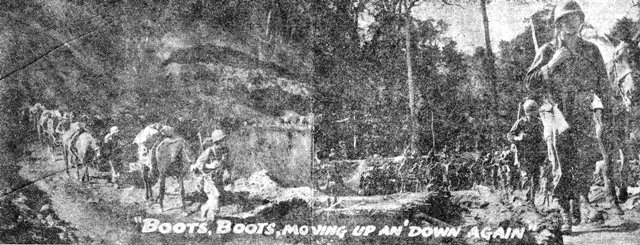
|
|
As soon as possible, the Roundup will publish a picture page of American Infantry in combat in Northern Burma. The photographs are even now being rushed to this newspaper. Meanwhile, we introduce you today to Merrill's Marauders as they sloughed toward the front lines, preliminary to their swift flanking movement along little-known trails to clamp a road block on the Japanese at Walawbum, 10 miles along their route of escape to the south.
Between this road block and the Jap bastion of Maingkwan, the enemy was encircled on all sides - north, east, south and west - by both Americans and Chinese. When a Chinese tank force moved swiftly into action, trundled down the main communication artery and joined Merrill's Marauders at Walawbum, mauling the Japs severely en route, the rout of the enemy was complete.
Within their first week of savage combat, the American doughboys killed an estimated 800 Japanese, while their own casualties were only a small fraction of that number. Many of them averaged 10 to 12 Japs. The enemy tried all it's usual tricks. However, few succeeded. Fast manuevering frustrated the foe and, in the few cases of ambush, it was reported by Lt. Gen. Joseph W. Stilwell that "we caught the ambushers."
The work of Brig. Gen. Frank Merrill's outfit not only inflicted heavy casualties among the enemy but also helped speed up his withdrawal from Mainkwan and Shingban.
Merrill reported that the longest single day's march by his force while behind the Jap lines was 26 miles with only a four hour break, adding that this included several river crossings.
Exterminated in the mop-up of the Maingkwan-Walawbum area was the highly-vaunted Japanese 18th Division, veteran troops which took Singapore.
Merrill told how during the present lull, Infantrymen who figured they didn't get their quota of Japs are spending time with patrols mopping up remnants of the encircled enemy force.
He explained the preponderance of enemy casualties by revealing the accuracy of American marksmanship as compared with the "lousy shooting" of the Nips.
Many enemy dead had three or four bullet holes in them and few shots missed their mark.
14TH A.F. VISITS JAPS IN BIRTHDAY RAIDS
CHINA - Pilots of the 14th Air Force made certain that they would have something over which to celebrate their first anniversary, March 10, by staging widespread sweeps into enemy-occupied territory during both day and night.
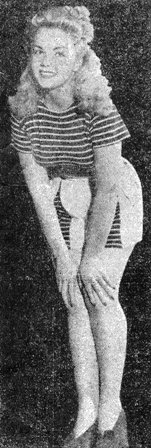 Pretty Angela Greene rested a steno's notebook on those shapely knees until a movie executive happened to take a
peek and, well, she was signed to a contract before you could say "teekah."
Pretty Angela Greene rested a steno's notebook on those shapely knees until a movie executive happened to take a
peek and, well, she was signed to a contract before you could say "teekah."
|
In daylight, fighter-bombers opened up by dive-bombing and strafing a 1,700-ton tanker near Campha Port, in French Indo-China, attacking a Jap airdrome on Weichow Island in the Tong King Gulf, and hitting other installation at Cao Bang and Luc Nam, in French Indo-China. Fighters dive-bombed and strafed a 1,600-ton freighter off Hongay to complete activities.
During the night, B-24 Liberators pounded the Kowloon Docks at Hong Kong, crashing many bombs into the target area. From these operations, one American aircraft is missing.
Two Jap aircraft bombed and strafed an airbase at Kweilin on the night of March 10, but only minor damage was caused.
STEWART 14TH'S LEADING FIGHTER ACE
GOULDTHRITE, PEACOCK SHARE HONORS AMONG SERGEANT GUNNERS
CHINA - On the eve of its first anniversary, the 14th Air Force announced its leading pilots and gunners, with coinfirmed Jap planes destroyed in the air only listed in the total.
Capt. John S. Stewart is the leading fighter ace, with nine victories, while the bomber gunners have two pace-setters, T/Sgt. George W. Gouldthrite and S/Sgt. John Peacock, each with five decisions.
Other fighter leaders are: Lt. Col. Elmer W. Richardson, eight; Col. Clayton D. Vincent, six; Lt. Col. Robert L. Liles, Col. David L. Hill and Capt. Samuel P. McKinsey, five, and Capt. William O. Morin, Capt. Robert V. Schultz and Lt. Lee O. Cregg, four.
Sergeant gunners behind Gouldthrite and Peacock are T/Sgt. Stanley L. Marshall, with four, and S/Sgt. Marino Galluzzo, with three.
HOTTEST FOOD EXPERTS
MERRILL'S TROOPS FROM SOUTH PACIFIC
NORTHERN BURMA - Hottest experts on living in the jungle are Brig. Gen. Frank Merrill's combat teams from the South Pacific. They know all the tricks, including how to live on K Ration. By mixing canned ham and eggs with biscuits, they fry pancakes, using a shovel blade for a griddle. With rice captured from the Japanese or borrowed from the Chinese, they make delicious pudding with the help of the D Ration's bar of chocolate. They call themselves the "Chow Raiders" and use little vest-pocket size can openers that come in 10-in-one Rations for insignia. Their war cry is borrowed from the South Pacific: "Tojo Eats Manure." One of the Marauders' wags insists that he heard the Japs shout a counter-taunt: "Eleanor eats powdered eggs."
JAPANESE BULLET BOUNCES OFF NORTHERN BURMA - After the fall of Maingkwan and Walawbum, Brig. Gen. Frank Merrill, commanding Yank forces in the Hukawng Valley drive, revealed that at least 12 of his men owe their lives to their steel helmets, which disproves claims that the helmet has no place in the jungle. After a Jap bullet put a dent in his helmet that you could put your fist into, Cpl. Raymond Harris, of Pekin, Ill., who holds a Silver Star for heroism in the Southwest Pacific, killed seven of the enemy. |
|
THERE'S A CATCH ELIZABETH, N.J. - Local Draft Board Number Two of Union Township displayed a sign in its window, "Help Wanted - Male. Clothing, maintenance and $50 a month. Job not permanent." The board chairman said that the sign emphasizes the board's protest against drafting fathers, while single men are deferred for war work. |
HELMET PACKIN' JAP
WAKENS PISTOL PACKIN' MAMA'S BROTHER
NORTHERN BURMA - One beleagured Jap, encircled by American and Chinese forces between Maingkwan and Walawbum, hit upon a ruse to escape the tight noose around him. He picked up a Chinese helmet and started sauntering nonchalantly down the road in an attempt to pass through the Chinese lines and get back to his own retreating units. All went well, until he was challenged by a Chinese sentry. When the Jap soldier tried to run, he was shot, just four feet away from the jungle hammock where reclined Lt. Henry Alper, of Hollywood, former violinist for Artie Shaw and brother of the co-author of Pistol Packin' Mama. Alper, startled peremptorily from his dreams, was far from non-plussed, especially as he went flat on his --- trying to scramble out of his hammock.
AID FOR CHIANG KAI-SHEK'S ARMIES
Most Ambitious Program In Military History
WITH THE CHINESE EXPEDITIONARY FORCE - Revitalization of Chiang Kai-shek's armies has begun with the arrival of concrete American aid.
This is the first public disclosure of one of the most ambitious and far-reaching programs in military history, to modernize, re-train and re-equip a vast army in wartime.
American Army oficers and men under Lt. Gen. Joseph W. Stilwell's command have started the job in southwest China in co-operation with the commanders of the Chinese Expeditionary Force.
The entire program envisages the re-training of several score divisions in critical areas where they will do the Japs the most harm.
Secretly at work since last April, Stilwell's "Y" Force Operations Staff, under Brig. Gen. Frank Dorn, is making real impression in its mission of stepping up the fighting efficiency of the expeditionary force.
The program has reached the point where American traveling instructional groups and liaison teams are in the field with Chinese Army groups.
Front line soldiers in some cases have received American weapons and ammunition and learned their tactical use from Chinese officers and non-coms, recent graduates of American training schools.
After seven debilitating years of defensive struggle aginst the relentless, modernly-srmed invader, some large units of the Chinese Army at last are able to begin thinking in terms of the day when they will be able to turn to the offensive and drive the enemy from the continent of Asia.
Viewing the China war picture as a whole, however, there is still a staggering job ahead. To a large extent, it hinges on the opening of the overland supply route from India for which the Chinese-American Expeditionary Force under Stilwell is fighting ahead in Burma and the eventual seizure of a seaport on the China coast. American personnel and material are now limited to what can be flown in, in addition to the needs of the 14th Air Force and the Chinese Air Force.
Concrete aid has been extended in the following categories: Air-ground support; Anti-aircraft batteries; Ammunition (in considerable quantities); Weapons, including mountain artillery, machine guns, anti-tank guns, mortars and tommy guns; Radio and Signal equipment; Motor replacement parts, gasoline trucks; Field Hospital services; Veterinary services; Ordnance repair; Engineering and road construction; and field training in tactics of the use and care of weapons and bayonet fighting, operation of signal equipment, air and ground co-operation, care of animals, sanitation and preventive medicine.
In a 1,500-mile trip through the lofty mountains and valleys of Southwest China, I had the first opportunity to visit and talk to the Chinese and Americans working and living side by side in the field to create a new striking force in the framework of the Chinese armies that have been facing the Japanese since the enemy over-ran Burma, Thailand and French Indo-China.
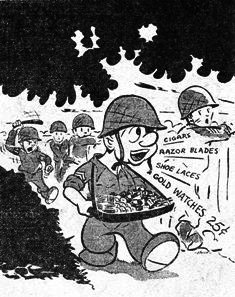
|
The trip covered a wide area from the CEF headquarters of Gen. Wei Li-huang to the front lines.
Despite what might have been considered insurmountable difficulties a year ago and some misgivings on both sides, the groundwork has been laid. Training is going into the final stages down into the lower units. Chinese and Americans have reached working basis of mutual respect, understanding and co-operation.
American supplies have been obtained in a sufficient quantity that Lt. Gen. Hsiao I-Su, CEF chief of staff, can tell me:
"We have been supplied enough weapons for this front, CEF is adequately equipped, for both offensive and defensive operations."
American traveling instructional groups and liaison teams attached to the Army groups have been in the field nearly four months, carrying down from the top to the lower units the training program that was initiated last April with the establishment of large infantry and artillery training center in the rear, attended by hundreds of Chinese officers and non-coms, who, in turn, have become instructors.
Commanding the units are Cols. Walter Wood, Reynolds Condon, Hubert Cole, and Phillip Enslow. The Y Force forward echelon is commanded by Col. George Byers.
Like their Chinese comrades, theAmericans, with the exception of a small supply of canned milk, coffee, cigarettes and a few other Stateside supplemental rations, live off local purchases in the area where the foodstuffs are none too plentiful.
Rice is the standard fare and in a number of messes you use chopsticks instead of a knife and fork. Some units live in old temples and others are under canvas. Strict precautions are taken against malaria, typhus and numerous other diseases.
Early reluctance in some Chinese quarters to extend the fullest co-operation is gradually wearing down and the position now is that some commanders are so enthusiastic over the results that they have put in requests for more American personnel than can immediately be supplied.
As one American officer whose patience was taxed in the early stages put it, "I guess that's understandable. If the shoe were on the other foot and the Chinese came over to the United States to help put our Army in shape, the situation might be more acute."
Chinese officers and men take quickly to American instruction. It is given to them in concentrated doses with all the unessentials discarded. In many cases students make more rapid progress than our own G.I.'s when they are inducted, American officers said.
 Cpl. Fred Kennon packs eggs for air dropping, 200 to the basket. Rice husks are used to cushion the fall instead of
sawdust. No complaints have yet arrived that the hen fruit has been splashed by impact on the ground.
Cpl. Fred Kennon packs eggs for air dropping, 200 to the basket. Rice husks are used to cushion the fall instead of
sawdust. No complaints have yet arrived that the hen fruit has been splashed by impact on the ground.
|
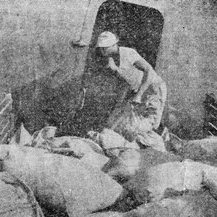 Rice is loaded into an air-dropping plane by Sgt. Edward Gee, member of a Quartermaster Truck unit in Assam. The rice
will soon be 'chuted to troops serving in the Burmese jungle.
Rice is loaded into an air-dropping plane by Sgt. Edward Gee, member of a Quartermaster Truck unit in Assam. The rice
will soon be 'chuted to troops serving in the Burmese jungle.
|
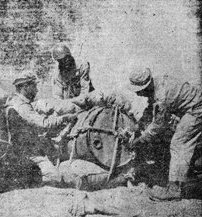 Cpls. Ron Cuff, Eugene Penn and Pfc. George Howard prepare high octane gas for dropping to forward units. Three parachutes
lower the barrel to the ground to cushion the bump when the load hits.
Cpls. Ron Cuff, Eugene Penn and Pfc. George Howard prepare high octane gas for dropping to forward units. Three parachutes
lower the barrel to the ground to cushion the bump when the load hits.
|
14TH A.F. CELEBRATES ANNIVERSARY;
CHENNAULT SENDS MESSAGE
> The following is the inspiring anniversary message sent to all units of the 14th Air Force by its commander, Maj. Gen. Claire L. Chennault. On July 4, 1942, the historic American Volunteer Group was dissolved and assimilated into the China Air Task Force, which in turn, on March 10, 1943, became the 14th Air Force.
Friday, March 10, 1944, is the first birthday of the 14th Air Force. It is a date which I think will be remembered as a significant milestone along the road to final victory.
Among the great Air Forces of the United States, the 14th is still small. Yet we can claim achievements of which I believe a far larger force might resonably be proud. Let me rehearse the record for you.
During the past year:
We have defended, against a far more numerous enemy, almost the entire area of Free China. When the enemy has attacked, we have taught him how it feels to suffer losses of six or seven or eight or even nine for one.
ATTACKED REPEATEDLY
We have ourselves attacked, repeatedly, with determination and with success. They know the sound of our aircraft, and of our bombs dropping on the yangtze River, in Hong Kong and Canton and Amoy and Swatow, of Formosa, and in the Japanese-held ports and bases of Indo-China, Thailand and Burma. Small as we have been and still are, we have made our attacks felt where it has hurt most. The sea routes between the Japanese Islands and the Japanese Empire are the jugular of the Japanese military system. We have stabbed tirelessly for the jugular, and since March 10, 1943, we have certainly sunk 274,939 tons of enemy shipping, and probably sunk or damaged another 282,550 tons. Some day, I venture to predict, we shall cut the jugular and the organism will die.
|
TO CHENNAULT |
Finally, we have fought side by side with our Chinese allies, and we have been victorious. In the Tung Ting Lake campaign last summer, in the battle for Changteh last fall, we powerfully supported China's armies, who met the Japanese and drove them back.
PROUD OF RECORD
We can be proud of such a record. We can be proud also of the growth that has come during the past year. The 12 months from March 10, 1943, until today have seen the establishment of the Chinese-American Composite Wing, in which Chinese and Americans live together, work together and enter combat together. The Chinese-American Composite Wing's record will speak for itself. The same 12 months have also seen the establishment in China of the Air Service Command, to aid us in supply and maintenance; the expansion of our own fighting units, and their reinforcements with improved types of aircraft, and the construction of new airfields and improvement of old. It seems a long time since the establishment of the Forward Echelon of the 14th Air Force. Yet it was only 11 months ago that four officers journeyed to Kweilin to prepare for the occupation of our bases in East China. Last summer, with a mere handful of planes, the Forward Echelon withstood a most determined Japanese attempt to wipe it out by force of superior numbers; and now the Forward Echelon has been replaced by two powerful wings.
The 12 months to come will see, I am confident, a growth even more rapid, and success even more remarkable. There have been hard times in the past - I for one will not soon forget the days last July and August when our men at Kweilin hung on only be their own courage and the magnificient determination of the ground crews to keep planes in the air against all odds. There will, no doubt, be hard times in the future. But we are on the offensive, not the defensive, now. Soon or late, the end is in sight. As your General, I cannot foretell the date of victory, but I will say to you that if you go on as you have started, you will bring measurably nearer the day when Japan has been humbled, and we can all make that homeward journey which we so desire.

Everything is humming. Heard the latest rumor men? Paulette Goddard's coming! Careful, lucky Air Corps wolf, As you fly our gal up. We are desperate for dames To zoom our low morale up. Tall and slim upon the screen She holds our rapt attention. But now in person we shall see Paulette's THIRD dimension. Jungle life is growing stale, We're tired of meditating. Ripe for glamour and for fun: Goddard, we are waiting! Sgt. SMITH DAWLESS |
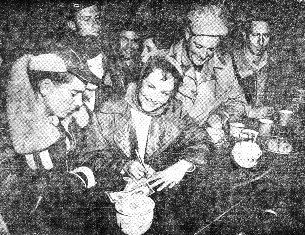 Like a shaft of sunshine piercing the gloom, La Goddard was greeted at an advance 14th A.F. base in China by
hundreds of enthusiastic G.I.'s after she, William Gargan, Andy Arcari and Keenan Wynn jumped the Hump to
entertain troops there.
Like a shaft of sunshine piercing the gloom, La Goddard was greeted at an advance 14th A.F. base in China by
hundreds of enthusiastic G.I.'s after she, William Gargan, Andy Arcari and Keenan Wynn jumped the Hump to
entertain troops there.
|
TANKS GO INTO ACTION
BREAK UP JAP FLANK ATTACK PLAN; MEDICAL OFFICER TELLS STORY
WITH STILWELL'S AMERICAN-CHINESE FORCES NEAR WALAWBUM, BURMA - American light tanks, crewed by some Americans but mostly by American-trained Chinese, went into action in Northern Burma for the first time. Since then, they have played a stellar role of the overwhelming victory of Lt. Gen. Joseph W. Stilwell's forces in the Maingkwan-Walawbum battle, which is now finished except for isolated mopping up.
Commanded by Col. Rothwell Brown, the tanks have been in contact with the enemy continuously since the foiling of the Jap plan, which was to let the Chinese proceed south along the road to Walawbum, then pounce on their flank from the east.
DRAMATIC TALE
Maj. Cornelius Wendell, 40, Medical Officer, told me a dramatic story of the tanks' first baptism by fire:
"We were east of Maingkwan in the afternoon. Two bulldozers cutting the jungle trail were ahead, with U.S. and Chinese infantry bringing up the rear. Suddenly, hidden Japs set fire to the elephant grass all around us. We shot and bulled our way through, riddling many Japs who exposed themselves. We kept going until just after dark. Then hell really broke loose.
"The Japs let us have everything in the book, including shells from 150mm cannons. We made it scalding hot for them too. The battle royal lasted all night.
"I have had bad nightmares, but I have never dreamed that shellfire could be so fierce. Once, I was so close to a Jap gunner that I could hear the plunk as he dropped the shell into the mortar barrel. I stuffed my pockets full of morphine bandages, wormed my way from tank to tank, treating the wounded. Whenever I had seconds to spare, I dug a hole with my hands. By morning, my hole was only deep enough for my head and shoulders.
ONLY DEAD JAPS
"In daylight the tank crews saw they had been fighting amid a hug Jap camp, but there were no Japs in sight, except dead ones. Jap huts extended seven-tenths of a mile in one direction and two miles in another. Brown's personal tank halted only 15 feet from the Jap command post.
"Of the large number of tanks, only a few were put out of action. Most had been repaired and were back in action. One bulldozer was damaged by 37mm which was fired point-blank.
"American and Chinese casualties were only a fraction of the Japs, who lost at least 200 killed.
"For the next five days, the tanks moved steadily southward to join Merrill's Marauders at Walawbum, hacking away at the Japs night and day."
Wendell said the tanks killed "at least 500 Japs" over the whole period.
Brown, Lt. Col. McPherson Lemoyne, Woodsfield, O., and Maj. Nellus Rhodes of meadville, Pa., had a narrow escape when they climbed out of their tanks to examine one burned out near Walawbum. They finished their examination and returned to their tanks just as Jap machine gunners in a tree fired on nearby Chinese, who whipped around and shot the snipers out of the tree.
ACTION MYSTERY
"It is a mystery to me why the Japs let us go and picked on the Chinese. Mebbe they did not like our looks," said Brown
Wendell, who has been in the Army since November, 1941, said Brown had not slept for the past six days and nights. "I've been trying to get him to sleep, but all he wants to do is kill Japs," Wendell said.
Brown, son of Hearst's Washington columnist, has been in the CBI more than two years. He instructed British and Indians in tanks before he started to train the volunteer Chinese in India last June.
Most of the Chinese were formerly farmers who never drove an automobile and never saw a tank. Brown whipped them into shape, some in two months, compared with the usual two years training for tank crews which fought in North China.
Some of the Chinese are only 14 years old. They average 18½. Most weigh only 110 pounds - living proof that it does not take a big man to handle a tank.
Brown taught the raw Chinese not only to drive tanks but to maintain them. The tank outfit includes mobile machine, welding, automotive and small arms repair shops.
Heading maintenance is Lt. Richard Zettwoch, College Point, Long Island, whose father is a New York Daily News printer.
"Without top maintenance we would have to give up," Brown said. "Zettwoch is the best damned maintenance officer in the United States Army."
By working 15 hours daily, Zettwoch trained the Chinese to jerk an old motor and install a new one in five hours.
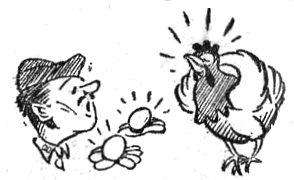
|
SUPER-FRESH EGGS FOR CAPT. DOUGLAS
ATC ASSAM BASE - Capt. Melvyn Douglas, Hollywood's gift to the CBI and at present pater familias for the swelegant Swing Patrol on tour in these provinces, ate at least two eggs on his trip that he knows were fresh.
On one occasion, Mr. and Mrs. Hamish Grant, prominent tea planters of a certain neighborhood, invited the handsome captain to spend a night with them as a respite from charpoys and G.I. chow. When showing him to his room, however, the hostess was horrified suddenly to hear an all-too-familiar cluck-cluck-cluck from a wardrobe in the corner.
Investigation proved that one of the Grant's home-loving hens had slipped into the bungalow and made her nest in an old hat of Mr. Grant's. Inside the hat were two freshly-laid eggs.
Mrs. Grant met the situation by quipping, "Just an old Assam custom, captain. We always do that so that our guests will know in their own minds that our eggs are really fresh."
EAC HAS BANNER WEEK
46 JAP PLANES DESTROYED IN BURMA DURING 24-HOUR PERIOD
The Eastern Air Command spent this week handing the Japanese Air Force in Burma the worst time it's had since the Nips took over in May, 1942.
It started on March 8. That afternoon, a flight of U.S. P-51's, having a look at the enmy fields at Shwebo, Aniskan and Onbauk, in Central Burma, caught a group of planes on the ground. When the shooting stooped, 32 Jap aircraft would never fly again, and neither would quite a few of their crews. A little later, RAF fighters attacked the area, and shot up additional grounded aircraft.
TOOK ANOTHER LOOK
That night U.S. medium and fighter-bombers came back for another look. They caught a dozen more on the ground and knocked them off, also causing two heavy explosions on the field at Shwebo, and the next morning fighters came back to destroy a medium bomber - bringing the bag for the period to 46, all without a single U.S. loss.
Not satisfied with this, U.S. fighters looked over Heho, Aungban and Meiktila field on March 11 and found the Nips in the air as well as on the ground. When that scrap was over, 15 Jap planes had been destroyed - nine in the air and six on the ground - and 11 had been damaged - eight in the air and three on the ground.
TACTICAL A.F. BUSY
Throughout the week, both RAF and U.S. units of the Tactical Air Force were busy too, attacking Japanese dumps, gun positions, communications and troop concentrations over almost all of Burma, in support of all land operations.
The Strategic Air Force also took a hand in the general destruction. RAF and U.S. heavies and mediums pounded Mogaung and Kamaing to a pulp, and the RAF spent a lot of time working out on railroad lines and stores areas in Central and Southern Burma. Both of them had a go at shipping and communications in Bangkok, causing heavy damage. On the night of March 7-8, the 7th Bomb Group sank a 200-foot freighter, probably sank a 300-foot freighter and damaged a 350 to 400-foot freighter in the Gulf of Siam. Moulmein and Prong Island also took a beating in combined operations.
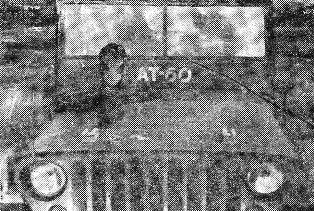 'BLACK DON'
'BLACK DON'
|
YE ED -
Seeing the picture of the DEAD python on the jeep raised our ire. Anyone can pose with a dead snake. But how about a LIVE one?
The pictured example is a King Cobra: "Black Don" by name.
"Don" is eight feet long and has full possession of his fangs and poison glands, and objected strenuously to being photographed. He is a representative of the world's largest poisonous snake. The bite of one of these fellows has been known to kill an elephant in three hours.
He is a gift to my collection by Col. Don Flickenger, Wing Surgeon. My snakes are a representaive collection, poisonous and otherwise, of the CBI Theater and my place id known as the "Reptile House." In peacetime, I was curator of reptiles for the Zoological Society of Long Beach.
The "Reptile House" has about 30 snakes and lizards, from all parts of CBI-land. The snakes are kept to give the "Humpers" an idea of the varieties it is possible they may meet. And I tell them what to do in case of snake bite "if and when."
Sincerely, Cpl. WESLEY DICKINSON, ICW-ATC
B-24 Destroys Zero Without A Shot
EASTERN INDIA BOMBER BASE - A group of Liberators were bombing a Jap airdrome deep in Burma. Among the attackers was a ship piloted by Lt. Raymond L. Cawood. As soon as bombardier Lt. James R. Meyer had laid his bombs, Cawood dived, turning steeply to avoid the searchlights and flak that was coming uncomfortably close.
The maneuver succeeded in getting them out of the searchlight glare, but over the interphone came: "Tail gunner to pilot . . . Zero at six o'clock . . . 300 feet below."
As gunner Sgt. Clifford L. Eastham echoed the report the voice of the navigator, Lt. Dante Mino, came over the interphone: "Do not go below 7,300 feet . . . mountains."
VISIBILITY POOR
The Zero was below and behind, waiting only until the Liberator came out of its dive. The visibility was too poor to get a shot at the Jap. Cawood glanced at his altimeter. It read 8,300 feet. Certain the fighter would remain below him, he decided to hold his dive until the last possible moment. The altimeter fell rapidly. The needle touched 7,500 feet - only 200 feet above the mountain - then the interphone became alive. "He hit that mountain! . . . Look at him burn! . . . . Tail gunner to pilot . . . that night fighter went into a mountain and exploded . . . I can see him burning."
RETURN HOME
Cawood leveled off his ship and returned home. An enemy ship had been destroyed without a shot being fired, thanks to a navigator's knowledge of terrain and a pilot's cold courage.
Other members of the crew were: Lt. George M. Hans, co-pilot; T/Sgt. Karl O. MacFarlane, engineer; T/Sgt. Elbert L. Iazenby, radio operator; S/Sgt. Laurel D. Disney, assistant engineer; Grant O. Allen, assistant radio operator, and S/Sgt. Philip R. Skaggs, armorer-gunner.
CHINA HAND NO STRANGER TO JAPANESE
REICH IN AT GROUND FLOOR DURING INVASION OF MANCHURIA
SKY DRAGON BOMBER BASE - Being alerted by the Japs is no new experience for T/5 Samuel Reich, of Seattle, Wash., who was in on the ground floor when World War II started 13 years ago with the Jap invasion of Manchuria.
Now 38, with nine years' service in the Army, Sam served with a machine gun company of the 15th Infantry Regiment at Tientsin from October, 1929, to September 1933, and can remember when the rate of exchange stood three Chinese dollars for one American.
After leaving the Army in 1933, Reich sampled the joys of civilian life until November, 1942, when he was notified that his friends and neighbors wanted him for you-know-what. He is now with a malaria control unit attached to the Sky Dragon medium bombardment squadron of the 14th Air Force.
14th Army Makes Gain In Arakan
Continuing their southward pressure on the Maungdaw-Buthidaung Road in the Arakan north of Akyab, troops of the British 14th Army this week took possession of the road's eastern anchor with the capture of Buthidaung and have greatly strengthened their positions by clearing the enemy from the high ground south and southwest of the highway.
|
14TH CROSSES CHINDWIN |
This followed continuing mopping-up operations to clear out isolated Japanese elements in the Htindaw area, where heavy casualties were inflicted on the enemy and large quantities of munitions captired, and British occupation of an enemy strong-point in the Razabil sector.
The capture of Buthidaung now leaves only a short stretch of the road in Japanese hands and gives promise of an early Allied conquest of the entire stretch. Meanwhile, advances were continued on the coastal plain south and southeast of Maungdaw, and seaborne raiders continued to harass Japanese defense elements farther south.
Elsewhere in Burma, West African troops were meeting heavy enemy opposition in the Kaladan Valley, and strenuous patrol activity marked the week in the Chin Hills and the Kabaw Valley area.
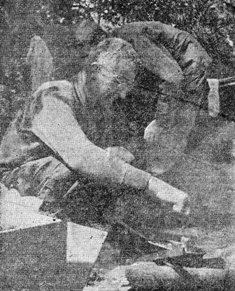 Brig. Gen. Frank Merrill, commanding U.S. Infantry troops which are driving the Japanese from the Hukawng Valley,
cooks his own rations over a bamboo fire in the jungle combat sector.
Brig. Gen. Frank Merrill, commanding U.S. Infantry troops which are driving the Japanese from the Hukawng Valley,
cooks his own rations over a bamboo fire in the jungle combat sector.
|
Yank Marksmanship Responsible
For Rout Of Jap Forces
NORTHERN BURMA - Brig. Gen. Frank Merrill, who lokks like a schoolteacher and has spent most of his time in the Army as military attache in Japan or riding a horse with the Cavalry, met the press in Northern Burma after scoring one of the most complete Infantry victories of this or any other campaign.
Officially credited with the extermination of 800 Japs, he lost seven killed, 37 wounded and two missing. Of the 37 wounded, only 11 required hospitalization. A pretty good score.
JAPS BAD SHOTS
"The reason for the preponderance of casulaty figures on the other side," Merrill explained, "was because the American can shoot. The Japs could never get their heads up. Every Jap killed by rifle fire had two or three holes in him. The Japs are lousy marksmen.
"None got by us down the road, but a few got away down new trails they cut for themselves. There are 50 or 60 of them loose up the river and some of my boys with poor records are out looking for them to build up their scores. It is open season; no limit on the bag.
"The first Japs we hit were easy. The ones who launched the frontal mass attacks were tough. We killed about 300 in that series of attempts at the river. Not a Jap got across. It might interest you to know that the lads still use the Southwest Pacific battle-cry 'Tojo eats manure.'
ENEMY OBVIOUS
"We found the Japs to be obvious. I don't think the Japs know how many men we had, because we kept them moving all the time. Their individual land mines are no good. One of my subordinate commanders stepped on one and just got his pants blown off.
"We lost more animals than men, but our muleskinners did a wonderful job of getting their animals to safety, keeping them quiet and packing and moving at night.
"I want especially to stress the fine co-operation we received from the Chinese 38th Division that hooked up with us. My men and the Chinese are getting along fine. They were all mixed up in camp the other night, sharing their food and having a hell of a time together."
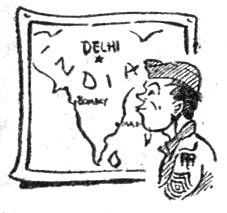
|
LITTLE WASHINGTON HEREBY WARNED
ASC JUNGLE BASE - When this squadron lost rugged 1st/Sgt. William V. Heskett to a lush assignment in "Little Washington," it also lost the key member of its famed "Tall Story Club."
Heskett should soon be telling his new comrades the famous yarn how he blew up a whole Jap airbase without going near the place. It won him the position of honorary president of the club.
"I was up in the hills looking for tigers," Heskett will undoubtedly relate, "when a Jap plane came over low returning from a bombing mission. A tank had been punctured and a thin stream of gasoline was streaming out, leaving a trail along the ground. I simply touched a match to it. The flames trailed that Jap clear to his base. I could see him twisting and turning, trying to get away from that relentless trail of fire on the ground. He couldn't do it. When he landed at his home base, the flames were right along with him. Of course, he blew up . . . and the whole damn base went with him."
Report Shows Lend-Lease Aid To CBI Theater
WASHINGTON - The report of Economic Administrator Leo T. Crowley on the third anniversary of Lend-Lease this week showed that the Allies in the CBI Theater were receiving a substantial part of the supplies sent to the Allies, which totaled $19,986,000,000 up to December 31, 1943.
Crowley revealed that shipments into China are increasing rapidly, with December shipments equalling all those for 1942. Total aid to China thus far comes to $2,995,000,000 plus $191,731,000 consigned to the U.S. Army in India and assigned for transfer to the Chinese.
Exports to India totaled $849,452,000 of which $554,015,000 was for munitions. Shipments of industrial machinery to India totaled $250,000,000 while agricultural products were valued at $45,000,000.
Crowley revealed that India also had a part in reverse Lend-Lease. While he did not break the figures down, he said India, United Kingdom, Australia, and New Zealand have spent over $2,000,000,000 for supplies and services to the U.S. forces from June 1, 1942 to Dec. 31, 1943.
Congress is now considering extension of Lend-Lease for another year, beyond the present June 13 expiration date. Secretary of the Navy Frank Knox, Crowley and Maritime Chairman Emory S. Land are among figures who have testified before the House Military Affairs Committee, urging Lend-Lease be extended.
Sergeant Holds CBI Record
AIR SERVICE COMMAND BASE IN ASSAM - He's got more years than most G.I.'s have months in the Army - and there's little chance of anyone catching up to his

Long, Long Trail . . |
Mild and soft-spoken, Jimmie's face beams with a modest, Irish smile when you ask him about his career. He'd rather pass it off with, "Just an Army life," but then you wouldn't know about his raising the first American flag over Gen. Pershing's headquarters in France, where he served for 27 months in the last war; his six years in Alaska where he trained with dog-teams and snow-shoes and hunted moose and caribou for passtime; his two years in the Philippines and the South Pacific islands; his celebrated days of sabre drill and mounted wrestling exhibitions while he was with the 12th Cavalry in the Northwest.
He was among the first to go over in '17 and again he was among the first to arrive in CBI-land. When he was stationed at American headquarters in France, he and a young sergeant who was Pershing's chaffeur became fast friends. The sergeant was Eddie Rickenbacker. He served there too, with a young cavalry captain who has carved his name in this war's fame - Lt. Gen. George S. Patton.
|
Quick
FAST THINKING NORTHERN BURMA - The Japanese tapped the frequency of Brig. Gen. Frank Merrill's voice radio. One night when he was trying to give orders to one of his combat commanders, Lt. Col. Charles Beach, the Japs tried voice jamming. Merrill, who was assistant military attache at Tokyo, stopped their jabbering by reciting Mamu Taro, a Japanese fairy tale. While they listened, he suddenly cut it short and got his orders through. |
|
INDIA EXPRESS LONDON - From Eastern Canada to Karachi, India, in 39 hours, 41 minutes. That's just what it took a new Liberator bomber recently. Normal flying time is five days. |
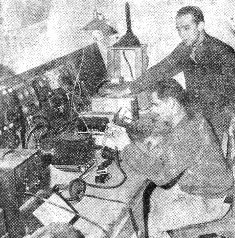 M/Sgt. L. G. Grim, left, and Capt. R. H. Morrison inspect their China radio station, built partially out of the
parts cannabilized from Zeros that went down before blazing 14th A.F. guns.
M/Sgt. L. G. Grim, left, and Capt. R. H. Morrison inspect their China radio station, built partially out of the
parts cannabilized from Zeros that went down before blazing 14th A.F. guns.
|
RADIO BROADCAST FOR CHINA G.I.'S
Thanks To Equipment Salvaged From Zeros
APO 430 - Thanks to the not-to-friendly visits of Mr. Tojo's little men to this advanced Chinese base, G.I.'s of the area are now enjoying nightly radio broadcasts of recordings and local talent over a home-built radio transmitter created by an on-the-ball G.I. who knows not to look a gift horse in the mouth when he sees one.
The station is bult of radio equipment salvaged from Japanese Zero planes which 14th Air Force sharp-shooters have sent flaming to earth within reach of this base. After enough of them came fluttering down, S/Sgt. Laverre G. Grim, of St. Louis, Mo., happened to notice that in many cases the radio equipment of the planes offered salvage opportunities.
A radio technician in civilian life, Grim started to collect odds and ends of mechanical and electrical equipment whenever opportunity offered, and finally managed to assemble enough to build his transmitter. Shortly thereafter, Station AWOL made its debut for the local G.I.'s.
Bishop Pays Tribute To Theater G.I.'s
LEDO ROAD - An Italian Roman Catholic bishop delivered a tribute to the spirit and kindness of America when he came here to hold confirmation services for 20 Catholic G.I.'s in the new chapel that Catholic Chaplain Louis J. Meyer had built up here.
The bishop, a big, rough-looking man with a beard, who was tending his wilderness flock here long before the war, delivered the sacrement, with a choir of 30 enlisted men, nurses and officers who had been training for months singing the mass.
After the service, the bishop commented, "I was surprised to see such a chapel . . . a cathedral; with so many people receiving communion. You Americans have done much for your missionary work here. You have given of your money, your time and of your faith, setting a fine example for the simple folk who were here before you came and who will be here after you go."

|
UNCLE JOE MARCHES FOLLOWERS
INTO THE GROUND
SOMEWHERE IN A NICE COZY CORNER OF A PADDED CELL - Trying to keep up with Uncle Joe Stilwell on the battlefront calls for a combination of the best in Gunder Haag and the worst in Boris Minnevitch.
You've got to be like Haag to keep up with the "old man" and have an ear for music, mostly flat, to keep from going nuts when Capt. Dick Young, his aide, gives out on his sweet potato.
Between the two, those who follow along figure they are running a bunion derby and have lost all taste for good music. There is one, and only one, blessing at the moment. Most of the element's of Stilwell's command can be reached by jeep.
In the good old days, battle-scarred followers would arise from their jungle hammocks, bathed what remained of their feet in Epsom Salts, and hopefully prepare for a day of rest. This always seemed to be a logical hope, because the campaign in those days wasn't going too fast and the Japs, thank God, would keep The Boss from walking all the way to Mandalay.
It was always when optimism had reached its peak that Young would appear, his charming Cantonese face wreathed in Fu Manchuish smiles, and announce, "Good news, my little chums. Draw two days' rations and get your field packs ready."
It finally got so bad that potential victims would sink off into the weeds any time that Young was seen coming in their general direction.
The boys used to make bets - all wishful thinking. They used to say, "He's 60 years old, he's bowlegged, maybe his feet are getting flat. He can't keep this up forever."
It is sad, but true, that Uncle Joe is 60, but nobody has told him yet. His legs do bow, which means he can take slumps frontally instead of from the flank. You couldn't flatten his feet with a sledge hammer. When he moves and you've got to move with him, there's no way out and it's just damn well Fate.
So Fate catches you and you move. Here's what happens - or at least what used to happen until we started moving down the blessed Ledo Road, Everybody would pile into jeeps, sheer luxury, and jolt for a couple of miles in the general direction indicated. The party would reach a spot where even the jeep couldn't operate anymore and it was the order to dismount and prepare to march.
The column would then proceed by marching (remember those deathless field manuals, fellows) until either the destination or complete mental or physical paralysis had been reached. The paralysis normally came first.
The general usually livened up the party with cheery little quips such as, "Your face is rather flushed" - "Mr. Brown, the trail's in rather nice shape today."
You can put it in your pipe and smoke it when he said the trail was in rather nice shape. It only had mud to your knees. Chinese pack trains in your hair and glades where you had to get down on your hands and knees to "proceed by marching."
You see, the general follows the book. The book says to march 105 paces per minute and, by God, he marches 105 paces per minute whether it be in mud, swamp or over a cliff. There is a rumor that he was training to be a human fly before his father put him in West Point. West Point must have caught hell for four years.
After you get where you're going, you fall down in the mud, dust and the always-present brambles, and don't complain. You made it, and brother, that's something. After a certain length of time you listen for heart-beats and decide the body still retains life, so you stagger out and swing the jungle hammock.
Then you eat those delicious Philadeplhia Quartermaster Depot rations and decide there is some hope remaining in this vale of tears. Then come the plaintive wail of the wood wind, normally Red Wing. The aide is giving forth on the little black bastard of the flute family, an instrument conceived in frustration and dedicated to the oral torture of manking.
Don't misunderstand. Everybody like the general and his aide. The only thing, the followers want to follow the general in Piper Cubs and knock all Young's teeth down his throat so he can't pucker up on the sweet potato for a while.
SWEETHEART OF APO 488 CHOSEN

|
APO 488 - Mrs. Marjorie Bailey, of St. Louis, Mo., wife of Crew Chief S/Sgt. George C. Bailey of this base, is the official "Valentine Girl of APO 488," and Maj. William H. McConnell, Executive Officer of the Blank Fighter Squadron, is the possessor of the most luscious pair of legs in this part of the province.
These were the sensational results of a gala affair staged to celebrate the opening for festive purposes of this outfit's new recreation hall and the arrival of two new Red Cross charmers, the Misses Hilda Vogel and June Baxter.
Mrs. Bailey was selected official Valentine Girl after long and conscientious study of photographs of wives and sweethearts submitted by G.I.'s in a spirited contest. The decision was reached by popular, secret vote, which made it surprising that any decision could have been reached at all except an overall tie, with each man voting for his own entry. The leg contest was purely impromptu, with McConnell regarding his smashing triumph as an honor of doubtful value in a war zone.
What with music, provided by T/Sgt. Tadejewski, CWO Whitehead, Pfc. Jarrell and S/Sgt. Bush, and ultra-delicious refreshments, the evening was an unqualified success. The committee in charge, composed of Sgt. Hunn, chairman; T/Sgt. Tadejewski, musical chairman; M/Sgt. Sampson, S/Sgts. Eble and Sangre, Sgts. Griffiths, Shanks, Brock and Cook, and Pvt. Ason, gets the credit.

Ledo Medics Stage Bouts With British
ALONG THE LEDO ROAD - An international boxing tournament was staged last week by American Medics and boys from a nearby British Ack-Ack unit. Challenged by the Yanks, the Tommies accepted with notable enthusiasm.
Col. Halton Gale, C.O. of the Acks, agreed to American rules and judges on condition that all matches be called to a decision. After preliminary exhibition bouts, Scotland's Gunner Logie and Francis (Cat-foot) Cook stepped into the spotlighted jungle arena for three fast rounds in which Lightning Logie outpointed Cook and scored a clean win for the British.
Welterweights Cpl. Ferrol Meats and Lance Bombardier Grundy matched blows next. Grundy, game to the last slug, was defeated by heavy-swinging Meats, tieing the score
In the next bout, neat-muscled Robbie Gutierrez won with a cool defense and split-second thrusts over Lance Bombardier Scott, who, although a novice to boxing, gave an excellent account of himself.
After an intermission for cookies and java served by the Red Cross Mobile Canteen, songs by Hal Belfer and petite ARC-angel Audrey Edmonds, the big event of the evening rolled around when Youngstown's Tony Vagnarelli tangled with stocky Gunner Kirkwood. Kirkwood, a seasoned lightweight, won a notable victory over hard-smashing Vagnarelli, who was not up to form shown in an earlier tournament.
The score was two up. Spectators stood tense as ring-wise Sgt. Eddie Kaucher took on scrappy Gunner Cooney, and broke the tie in favor of the Americans.
Lots of credit goes to ex-fighter T/5 Louis Perkins, who trained the Americans and to Sgt. Wifred Robinson, physical instructor for the British, both of whom acted as seconds during the match.
LOOP HONORS WON BY ASSAM MEDICOS
ASSAM - The station hospital Medics at this base boast one of the strongest softball teams in CBI. After losing their initial tilt, 6-5, to a fighter outfit, the Medics have rolled to eight straight behind Earl Rea, top pitcher in the Upper Assam League. Rea's latest win was a 9-6 mastery over an Ordnance outfit when homers by his teammates aided. Rea has a no-hitter to his credit here.
Other players on the team are: Jack Ranhofer, c; Dick Cunnigham, 1b; Joe Rogala, 2b; Eddy Brazee, 3b; Charlie Jones, ss; Hal Widdos, cf; Sam Merchant, rf, and Leon Dunn, scf. Other regulars include: Eddy Nicholson, Levin Twilley, Mike Lacusky, Gordon Mayo and Wilson Maloz.
A-3 WINS 14TH A.F. PENNANT, BECOMES TOURNEY FAVORITE
14TH A.F. HQS. - Even easier than had been predicted, A-3 defeated A-G in the final round of the 14th Air Force Headquarters Softball
|
CAPE GLOUCESTER (ANS) - S/Sgt. Jeremiah A. O'Leary, U.S. Marine Corps correspondent, described in a dispatch a Japanese charge of Marine lines, during which enemy soldiers shouted: "To Hell with Babe Ruth." O'Leary wrote that the charge was scored as "an error" and that "30 Japs were struck out for good." |
This easy league triumph places Col. John Neal's sluggers in a foremost position for the Rice Paddy League Conference, which begins Sunday. This world series affair includes 36 teams, making it the largest sports event for American troops in the CBI Theater.
Final standings in the local-loop, which played five games, found A-1 second with four wins and a loss. Communications, SCU, and A.G. tied for third on 2-3 records and A-2 alone in the cellar, 1-4.
Six runs in the fourth brought A-2 a win over A-1, 6-2, in their final meeting, but the biggest rally of the season was SCU's last-frame uprising to beat Communications. When they came to bat in the last of the seventh, SCU trailed by 8-0. They scored 10 runs to triumph, 10-8.
Six players, including Maj. Gen. Claire L. Chennault, commander of the 14th, hit .600 or better in loop play. The CG banged out 9 hits in 15 tries, one more than his battery-mate, Brig. Gen. Edgar Glenn, for his .600 mark. Others with high averages were: Meadows, who led with .666; Wedlan, .625; Amen and Smith, .615; Pace, .611.
The C.B.I. Roundup is a weekly newspaper published by and for the men of the United States Army Forces in China, Burma, and India, from news and pictures supplied by staff members, soldier correspondents, the United Press, and the Army News Service. The Roundup is published Friday of each week and is printed by The Statesman in New Delhi, India. Editorial matter should be sent directly to Lt. Floyd Walter, Rear Echelon Hq., U.S.A.F., C.B.I., New Delhi, and should arrive not later than Monday in order to make that week's issue. Pictures must arrive by Sunday and must be negatives or enlargements. Stories should contain full name and organization of sender.

MARCH 16, 1944
Original issue of C.B.I. Roundup shared by Virginia Dyer, widow of CBI veteran Stanley Dyer.
Copyright © 2006 Carl Warren Weidenburner
TOP OF PAGE PRINT THIS PAGE ABOUT THIS PAGE SEND COMMENTS
PREVIOUS ISSUE CLOSE THIS WINDOW NEXT ISSUE
